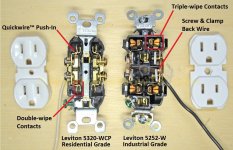The Code permits 15A receptacles on a multi-outlet 20A branch circuit. This implies that the 15A receptacle must support 20A feedthrough, in order to feed a possible 20A load downstream. But is this 20A feedthrough capability actually spec'd anywhere, either in the Code or in UL listing for the receptacle?
You are using an out of date browser. It may not display this or other websites correctly.
You should upgrade or use an alternative browser.
You should upgrade or use an alternative browser.
20A Feedthrough on 15A Receptacle
- Thread starter ChrisFV
- Start date
- Status
- Not open for further replies.
A receptacle is not a feedthrough actually. In fact, a preferred method for wiring a receptacle that is not at the end of the run is to pigtail the hot and neutral and connect the pigtail to the receptacle. If you have a backwired device, you might put both wires under either end of the backwire plate, but that's not feedthrough either.
- Location
- New Jersey
- Occupation
- Journeyman Electrician
The binding screw parts of the 15 amp receptacle are actually rated for 20 amps as part of the listing of the device. The feed-through current isn't actually going through the entire device it's just passing from one binding screw to another.The Code permits 15A receptacles on a multi-outlet 20A branch circuit. This implies that the 15A receptacle must support 20A feedthrough, in order to feed a possible 20A load downstream. But is this 20A feedthrough capability actually spec'd anywhere, either in the Code or in UL listing for the receptacle?
electrofelon
Senior Member
- Location
- Cherry Valley NY, Seattle, WA
How is it not a feed-through? Granted there is no definition of "feed through" anywhere but in practice I think most of us would call it feeding through.A receptacle is not a feedthrough actually. In fact, a preferred method for wiring a receptacle that is not at the end of the run is to pigtail the hot and neutral and connect the pigtail to the receptacle. If you have a backwired device, you might put both wires under either end of the backwire plate, but that's not feedthrough either.
- Location
- New Jersey
- Occupation
- Journeyman Electrician
I agree, feed-through is a common term used when there is no pigtailing.How is it not a feed-through? Granted there is no definition of "feed through" anywhere but in practice I think most of us would call it feeding through.
- Location
- Illinois
- Occupation
- retired electrician
From the UL Guide Information for Receptacles (RTRT)
Single and duplex receptacles rated 15 and 20 A that are provided with more than one set of terminals for the connection of line and neutral conductors have been investigated to feed branch-circuit conductors connected to other outlets on a multi-outlet branch circuit, as follows:
- Back-wire (screw-actuated clamp type) terminations with multiple wire-access holes used concurrently to terminate more than one conductor
- Side-wire (binding screw) terminals used concurrently with their respective push-in (screwless) terminations to terminate more than one conductor
LarryFine
Master Electrician Electric Contractor Richmond VA
- Location
- Henrico County, VA
- Occupation
- Electrical Contractor
The receptacle rating describes the slot configuration, not the conductive parts' ampacity. Most 15a and 20a receptacles of a given grade contain the same internal parts.
In the pic, note that, in the receptacle on the right, the Triple-wipe Contacts in the red box, either a horizontal or vertical blade will fit, and be touched in three places by the internal conductive parts. All they have to do to make a 20a version and/or a 250v receptacle, is put on a different face, either vertical, horizontal or T-shaped for each slot:

In the pic, note that, in the receptacle on the right, the Triple-wipe Contacts in the red box, either a horizontal or vertical blade will fit, and be touched in three places by the internal conductive parts. All they have to do to make a 20a version and/or a 250v receptacle, is put on a different face, either vertical, horizontal or T-shaped for each slot:

- Status
- Not open for further replies.

